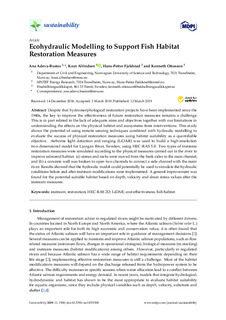| dc.contributor.author | Adeva Bustos, Ana | |
| dc.contributor.author | Alfredsen, Knut | |
| dc.contributor.author | Fjeldstad, Hans-Petter | |
| dc.contributor.author | Ottoson, Kenneth | |
| dc.date.accessioned | 2019-04-12T08:00:58Z | |
| dc.date.available | 2019-04-12T08:00:58Z | |
| dc.date.created | 2019-03-12T16:36:00Z | |
| dc.date.issued | 2019 | |
| dc.identifier.citation | Sustainability. 2019, 11 . | nb_NO |
| dc.identifier.issn | 2071-1050 | |
| dc.identifier.uri | http://hdl.handle.net/11250/2594394 | |
| dc.description.abstract | Despite that hydromorphological restoration projects have been implemented since the 1940s, the key to improve the effectiveness of future restoration measures remains a challenge. This is in part related to the lack of adequate aims and objectives together with our limitations in understanding the effects on the physical habitat and ecosystems from interventions. This study shows the potential of using remote sensing techniques combined with hydraulic modelling to evaluate the success of physical restoration measures using habitat suitability as a quantifiable objective. Airborne light detection and ranging (LiDAR) was used to build a high-resolution two-dimensional model for Ljungan River, Sweden, using HEC-RAS 5.0. Two types of instream restoration measures were simulated according to the physical measures carried out in the river to improve salmonid habitat: (a) stones and rocks were moved from the bank sides to the main channel, and (b) a concrete wall was broken to open two channels to connect a side channel with the main river. Results showed that the hydraulic model could potentially be used to simulate the hydraulic conditions before and after instream modifications were implemented. A general improvement was found for the potential suitable habitat based on depth, velocity and shear stress values after the instream measures. | nb_NO |
| dc.language.iso | eng | nb_NO |
| dc.publisher | MDPI | nb_NO |
| dc.rights | Navngivelse 4.0 Internasjonal | * |
| dc.rights.uri | http://creativecommons.org/licenses/by/4.0/deed.no | * |
| dc.title | Ecohydraulic Modelling to Support Fish Habitat Restoration Measures | nb_NO |
| dc.type | Journal article | nb_NO |
| dc.type | Peer reviewed | nb_NO |
| dc.description.version | publishedVersion | nb_NO |
| dc.source.pagenumber | 20 | nb_NO |
| dc.source.volume | 11 | nb_NO |
| dc.source.journal | Sustainability | nb_NO |
| dc.identifier.doi | 10.3390/su11051500 | |
| dc.identifier.cristin | 1684260 | |
| dc.description.localcode | © 2019 by the authors. Licensee MDPI, Basel, Switzerland. This article is an open access article distributed under the terms and conditions of the Creative Commons Attribution (CC BY) license ( http://creativecommons.org/licenses/by/4.0/ ). | nb_NO |
| cristin.unitcode | 194,64,91,0 | |
| cristin.unitname | Institutt for bygg- og miljøteknikk | |
| cristin.ispublished | true | |
| cristin.fulltext | original | |
| cristin.qualitycode | 1 | |

